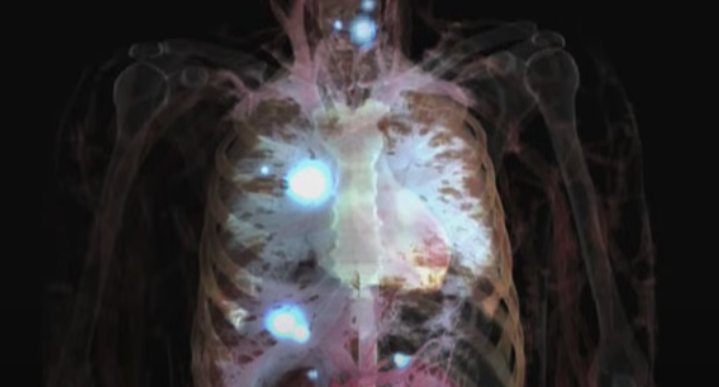 Cancer tumors in human body.
Cancer tumors in human body.In recent years, cancer research has entered a new frontier, propelled by revolutionary advancements in chemistry.
Among these innovations, photoredox catalysis and micro mapping are emerging as game-changers, paving the way for more targeted, precise, and effective cancer therapies.
Leading these transformative efforts is Sir David W.C. MacMillan, a Nobel Prize-winning chemist, whose groundbreaking work promises to shift the paradigm of how we treat and understand cancer.
One of the standout innovations introduced by MacMillan is the use of photoredox catalysis, a technique that leverages visible light to activate molecules in a precise and controlled manner.
Traditionally, the synthesis of complex molecules for cancer drugs involved harsh conditions and toxic reagents, posing risks to both patients and researchers. Now, scientists can harness light as a clean and efficient trigger for activating these molecules, generating reactive intermediates that target specific biological processes in cancer cells.
“By using light to activate drugs only within the cancerous tissue, we can dramatically reduce the damage to healthy cells, a major drawback of conventional therapies,” said MacMillan during his presentation at the 74th Lindau Nobel Laureate Meeting in Germany.
He noted that this breakthrough enables a new wave of cancer treatments that can selectively target tumour cells while sparing normal tissue, a concept that has the potential to drastically improve patient outcomes. In addition, he said that photoredox catalysis facilitates the creation of prodrugs molecules that remain inactive until they are exposed to light.
“This method enhances the precision of cancer treatments, ensuring that drugs are activated only when and where they are needed, reducing side effects and increasing therapeutic efficacy.”
Mapping tumor interactions with micro mapping. Another transformative aspect of MacMillan’s work is micro mapping, a technique that allows scientists to precisely map the interactions between proteins, nucleic acids, and other molecules in the tumor microenvironment. He indicated that tumors are complex ecosystems, where dynamic interactions dictate how cancer grows, spreads, and evades treatments.
“By understanding these networks, researchers can uncover new therapeutic targets.” Using a combination of photoredox catalysis and micro mapping, MacMillan and his team have developed a method to label and identify molecules in close proximity within the tumor, revealing hidden protein interactions that play crucial roles in tumor progression.
The chemist noted that this technique generates "footprints" of these interactions, allowing for the creation of a detailed map of molecular pathways that drive cancer.
"The beauty of this technology is its ability to identify not only what we already know about tumor biology but also what we’ve been missing all along. In one experiment, we were able to reproduce decades of research and simultaneously uncover a wealth of new molecular insights. That’s the power of micro mapping." MacMillan explained.
Tackling Drug Resistance MacMillan cautioned that drug resistance remains one of the most formidable challenges in cancer treatment.
He noted that many cancers develop the ability to evade therapies, rendering initially effective drugs useless. A prime example of this is HER2-positive breast cancer, where some patients develop primary resistance to targeted therapies like Herceptin. MacMillan’s work is tackling this challenge head-on.
By attaching photocatalysts to existing cancer drugs, scientists can now map how cancer cells interact with these therapies at the molecular level. This enables them to identify previously overlooked pathways and receptors involved in resistance. "By pinpointing the exact interactions that lead to drug resistance, we can develop combination therapies that bypass these escape routes, restoring the effectiveness of treatment," said MacMillan.
He said that recent breakthroughs have already led to new receptor targets that, when combined with existing drugs, help re-sensitize cancer cells, providing hope for patients who otherwise had limited options. Perhaps the most exciting prospect of this research is its potential to create personalized cancer therapies.
By utilizing micro mapping and photoredox catalysis, MacMillan indicated that clinicians can tailor treatments to the individual molecular profile of each patient's tumor. “This would allow for therapies that are not only more effective but also less toxic, offering the promise of precision medicine.”
Additionally, MacMillan's work is beginning to push the boundaries of drug delivery. “Researchers have identified small peptides that can cross the blood-brain barrier, a key obstacle in treating brain tumors and metastases. These peptides can now be used to carry large drug molecules directly into the brain, opening new avenues for treating previously intractable cancers.”
As the integration of catalysis, molecular mapping, and light-based chemistry continues to evolve, the future of cancer therapy looks brighter than ever. He further said that these advancements offer more than just new treatment options they provide a deeper understanding of the molecular mechanisms that drive cancer, enabling the design of therapies that are more effective, less toxic, and tailored to individual patients.
"The ultimate goal is to bring the power of chemistry to bear on cancer in a way that is both transformative and sustainable. By working together across disciplines, we can move from laboratory discoveries to life-saving treatments." MacMillan concluded that with continued research and collaboration, the Nobel Prize-winning chemist said that the dream of personalized, precision cancer treatments is fast becoming a reality.
As Sir David W.C. MacMillan's work demonstrated, chemistry holds the key to unlocking new and more effective approaches to one of the world’s most persistent and deadly diseases.











